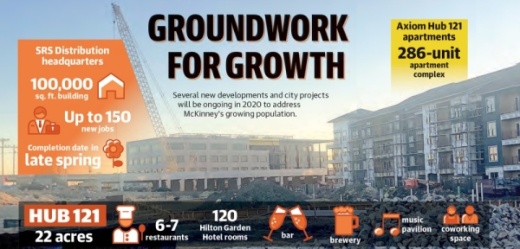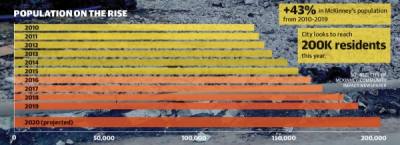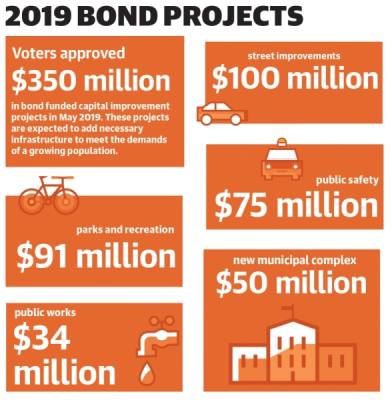Official population estimates will not be available until mid-January, according to the city, but as of Dec. 1, McKinney’s population sat at roughly 194,293 residents.
The population is not the only area of growth. McKinney also had the highest percentage of annual commercial growth in its history during 2019, which is important because it means “lower property taxes for our homeowners,” Mayor George Fuller said at the annual State of the City meeting Nov. 7.
With a growing city comes the need for new streets and developments, according to officials. A few of the bigger city projects, ranging from public safety to parks to street improvements, will be funded by $350 million in bond funds approved by McKinney voters last May.
New businesses are also a large part of new growth because of the new jobs and additional revenue they will bring into the city, according to city officials.
“It’s not just the jobs,” City Manager Paul Grimes said during State of the City. “They are bringing knowledge, education [and] experience that they will be able to impart in some way to our community.”
New City Hall
One of McKinney’s biggest projects to kick off in 2020 is its new city hall complex, which is planned to be six times the size of the existing City Hall and house nine departments. These nine departments are located in separate buildings in McKinney. The idea is to have all departments in one location and open up the existing spaces to other tenants, Grimes said.
“The wheels are moving on that, although we still have some land to acquire,” Grimes said.
The city is looking in the vicinity of the Flour Mill on the east side of SH 5, but a specific location has not been announced, and land negotiations are still underway, he said.
In 2020, the city hopes to acquire all necessary land and begin design work for the new municipal complex.
“We are looking [to build] on the east side to serve as a catalyst project for redevelopment of the east side of [SH] 5,” Grimes said. “That’s very exciting because that can be a major, major catalyst for redevelopment in a whole sort of uncharted territory of the city.”
Building the new City Hall there would likely create a new hub for development, including restaurants, residential spaces and more, Grimes said in a previous interview with Community Impact Newspaper.
“It would take in an old industrial area and sort of reform it into something kind of unique and interesting adjacent to our existing Town Square,” he said.
Once land is identified, a proposal will be brought to City Council for approval. The city will then finalize the purchases and put out a request for architectural design services for the new City Hall.
“We are hopeful that that will all be happening in 2020,” Grimes said.
A completion date has not been set, but Grimes said City Council is prioritizing this project.
Private development
Several economic development projects are in the hopper as well, Grimes said.
Raytheon, the city’s largest employer, is constructing a new 200,000-square-foot facility at its headquarters on US 380. The facility is expected to support about 500 new high-tech jobs in McKinney.
A new local spot for food, drink and entertainment is also under construction. Hub 121, McKinney’s newest mixed-use development, will include restaurants, bars, brewery, a fitness center, a coffee bar, a music pavilion, a hotel, a 286-unit apartment complex and more. The 22-acre development is located at the northwest corner of Alma Road and SH 121.
“Hub 121 will be close to completion by the end of 2020,” Grimes said.
In addition, urbanization in the Craig Ranch area is expected to continue moving east along the SH 121 corridor into McKinney, Grimes said during the Nov. 7 progress update.
Many other projects are expected to be announced this year, Grimes said.
“These economic development successes are so important for us because of the social and cultural capital they bring to our community,” he said.






